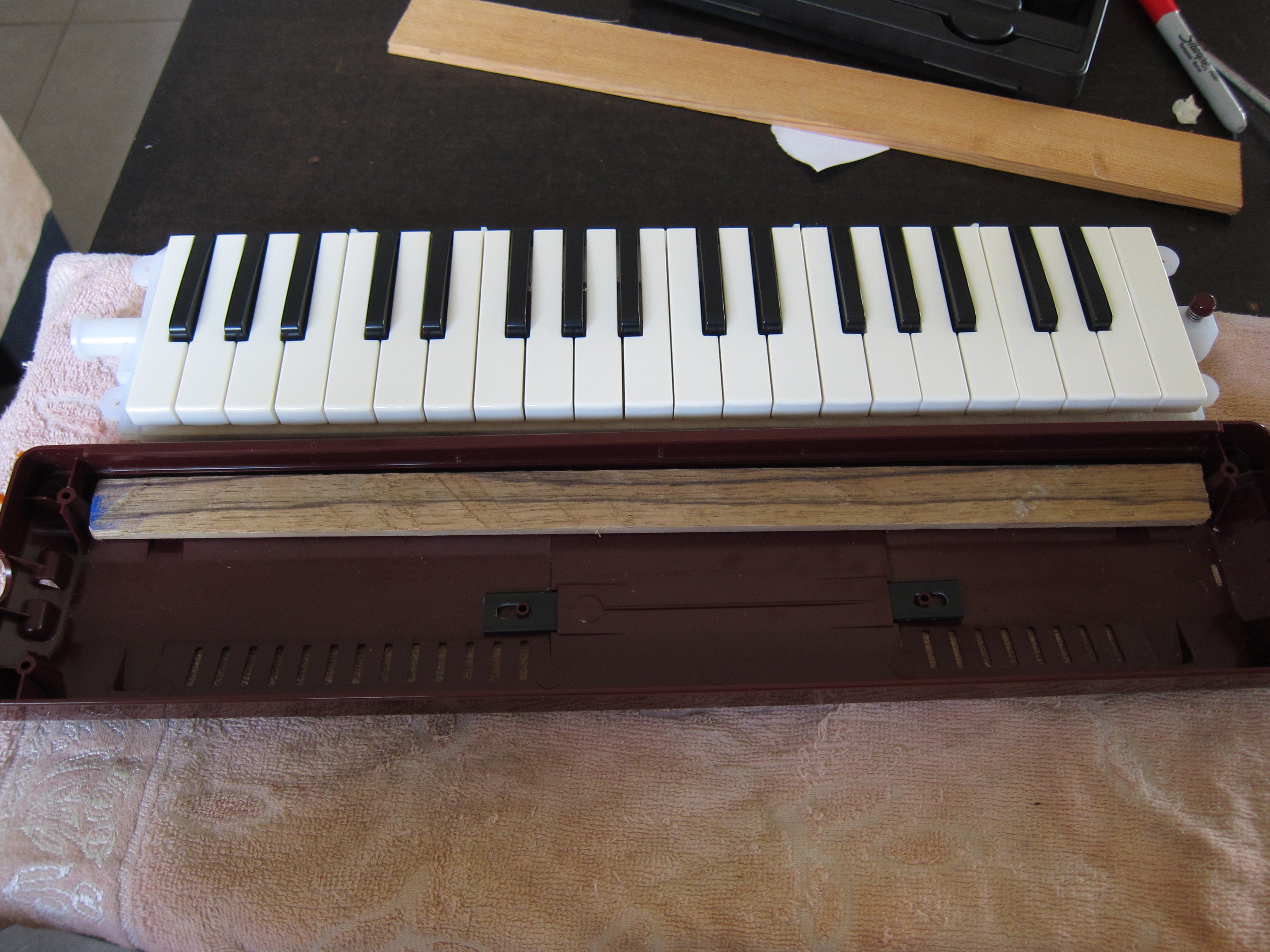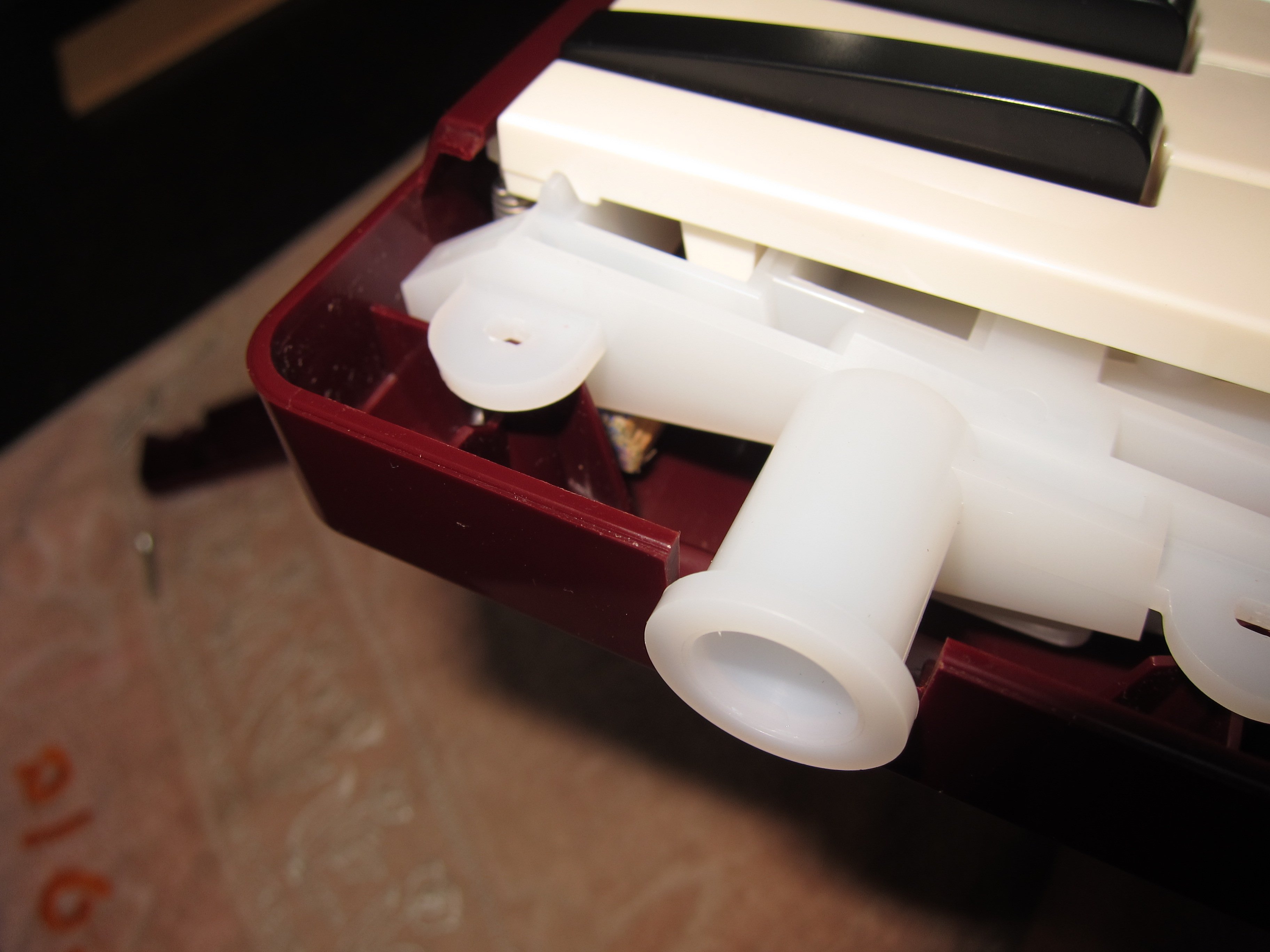Material test on Yamaha P37D
Tagged: Yamaha P37D wood
- This topic has 27 replies, 4 voices, and was last updated 8 years, 11 months ago by
 Ofir.
Ofir.
-
AuthorPosts
-
May 10, 2015 at 12:09 pm #5004
 OfirParticipant
OfirParticipantAs time goes by, and as I tried some other considerably good melodicas, I enjoy my Yamaha more and more.
One thing which differentiate the best known instruments from the rest its wood construction.
That called for a test: how better can the Yamaha be if it will reflect its sound into wood?After disassembling the instrument and playing while it lies naked on my wooden table, I noticed that:
1. It changes the sound
2. The instrument’s box is indeed important for its good sound.Then the I decided to perform a test where I put a wood part inside the Yamaha’s box near the pads area, where it reflects its sound from.
I chose a 50 grams generic wood I found in my dump, probably a piece that Stradivarius would never use for his instruments:
You can barely see it then the instrument is in place:


And now, to the recordings…
May 10, 2015 at 12:14 pm #5005 OfirParticipant
OfirParticipantThis test contains the same leak played over the low and high registers, recorded from different angles.
Each leak was recorded using the original instrument, and then the same with added wood into it. (I obviously did it in a different order, but I organized it like that so it can be compared better).
Everything was normalized so sound levels won’t make the difference.
Order of things:
(Keyboard mic)
low register without wood
low register with wood
high register without wood
high register with wood(Left mic)
low register without wood
low register with wood
high register without wood
high register with wood(Back mic)
low register without wood
low register with wood
high register without wood
high register with woodIt’s interesting to see what a 50 grams of wood can do to a 795 grams of instrument.
May 11, 2015 at 1:48 pm #5012 OfirParticipant
OfirParticipantAfter some time playing with the piece of wood inside, here are my impressions:
1. The instrument is noticeably louder, in a good way.
2. From the player’s position the sound is rounder and deeper. This is a subtle change, although it clearly sounds.
3. The instrument vibrates more with the sound, which is has a good psychological effect on me as a player (I also love that in pianos)It may present a nice alternative for adding the benefits of wood to the instrument’s acoustic without changing its tight air chamber, and without compromising on the quality of the instrument (unlike Mylodica).
May 11, 2015 at 4:54 pm #5013 Alan BrintonParticipant
Alan BrintonParticipantThanks for sharing the results of your very interesting experiment, Ofir. (Lovely playing, by the way.) I have a few questions:
(1) Is the piece of wood held solidly in place by being compressed between the two plastic surfaces?
(2) Do you anticipate having to change it out periodically because of the affects of moisture?
(3) Have you thought about the possibility of adding something to the reed chamber. I know there is very little space for that in a Yamaha. A strip of some kind of tape, maybe, or a thin layer of, say, adhesive backed felt.I’m supposing that felt would mute the sound, but I’m just mentioning that as an example of what might fit in the reed chamber and alter the sound (and/or reduce the size of the chamber).
I’m not an engineer, but I’m guessing that the vibration is due to the increased contact via the wood strip between the reed chamber cover and the main tray of the Pianica, as contrasted with a buffer of air?
May 11, 2015 at 5:19 pm #5014 Alan BrintonParticipant
Alan BrintonParticipantI don’t think we have discussed the tactile aesthetics of vibration here (except for a brief exchange in which Melodic-Me warned me about the dental implications of rattling one’s teeth on the mouthpiece).
May 11, 2015 at 7:19 pm #5015 DarenKeymaster
DarenKeymasterGreat experiment Ofir. And nice choice of wood 🙂
There’s a distinct difference in sound here. I agree, this may be the way to benefit from the sound of wood without touching the air chamber.
I wonder what would happen if you added more wood?
And what happens when the wood is added to change the sound? Hopefully there’s some scientific people here. It sounds like the wood has absorbed some higher frequencies and mellowed out the sound. It’s also changed the shape of the internal cavity of the case which has caused an increase in volume. Have you noticed any spikes in volume or tone across the whole range of the keyboard since adding the wood?
Alan, concertina and accordino makers often use leather for this very effect. Perhaps just coating 1 or 2 sides of each chamber would have an effect without reducing the space too much?
What happened with your Yamaha wooden case? Wasn’t your carpenter friend going to make one out of a solid piece of timber?
I’m currently building a wooden case to house a P32D out of plywood to see what sort of effect that has on the sound. It would be great to compare with your findings!
May 11, 2015 at 7:26 pm #5016 OfirParticipant
OfirParticipantHi Alan,
(1) The piece of wood is held between two screw holes with low amount of pressure (shown clearly in the first picture). I don’t really know if it actually touches the internal body, but shaking the instrument won’t make a noise so I guess that it does. It sits directly near the opening of the key pads, where most of the sound is projected from (I did an experiment on the inner body to determine where most of the sound is projected from).
I had several experiments putting it in different places where it either didn’t fit, or interfered with the key pads opening.(2) Although I think that THE flaw of Yamaha’s design is its stupid moisture release (inside the box), I actually found a way to let it out fast, keeping it very dry internally (more on the Yamaha P37D review I posted recently). Therefore, I estimate that moisture will probably cause no real damage the wood.
(3) In contrast, the reed chamber is very wet. Putting fabric of any kind in it will probably cause more standing moisture there, which may lead to future problems. Even if that wasn’t a problem, I think that the extremely tight air chamber won’t leave room for any additional materials in it. One wishing to mute the Yamaha may use my technique with a fabric instead of wood (in the relatively dry area). Anyway, I don’t see any reason to reduce the size of the air chamber; I really love the current design, it’s REALLY small! 🙂
As for the vibration, in the first test I made (putting the naked instrument on the table), the table vibrated very well. I guess that it’s basically because the wood in it vibrates (wood is a terrific medium for sound transfer, unlike plastic), and therefore having more moving material generates more momentum.The vibration that I noticed is one that I like, it reminds me of the vibrations of the Pro 36, which has wooden air chamber. Definitely not too much, and gives terrific feedback to the musician.
May 11, 2015 at 8:13 pm #5018 Alan BrintonParticipant
Alan BrintonParticipantI haven’t yet gotten together with my friend, Daren. He has been pretty busy with seasonal work on his day job, but it’s probably time to meet with him and show him some naked melodicas.
May 11, 2015 at 8:15 pm #5019 OfirParticipant
OfirParticipantHi Daren,
My strategy of choosing the type of wood was: “Yay, it fits!” 😉I’ll try to play the scientific guy here (yap, I’m doing many things) –
First, it changes the way the instrument projects its sound.
Instead of mostly sounding through a single hole (at the open keypad) which tries to force a plastic box to vibrate (not the best medium for sound transfer), it now has the wood vibrating relatively equally through all its length.
It’s the same as letting a tuning fork vibrate in the air, or attaching it to a wooden part (try a piano or a big table); same energy source, way better sound transfer.
It also changed the sound reflection pattern of the instrument. I.e., without the wood, I didn’t like much the sound when recorded from the keyboard side. With the wood, I really do.I agree about the change in the frequency domain, which may be different using (any type of) quality wood.
To me the sound is fairly stable and constant through all its range, no spikes or strange notes.May 11, 2015 at 8:21 pm #5021 OfirParticipant
OfirParticipantBy the way, all the pictures that I post are high resolution and stored on my website, so you can right click any of these and choose “view image” to see it in full size.
May 11, 2015 at 10:08 pm #5023 Alan BrintonParticipant
Alan BrintonParticipantOne giant step for Melodica-kind.
May 15, 2015 at 8:54 pm #5222 LowboyParticipant
LowboyParticipantThis is probably a good place to expose the naked truth. When I look under the covers of keyboard harmonicas I see one thing that surprised me. The reeds come before the air control valve. Hence, the reeds must be buried inside the instrument. I suppose this helps with tone and sound volume as the reeds are in chambers of varying designs.
The first time I saw this I was surprised as I just logically assumes the control valves would come first then the reeds. Harmonicas have the control valve first (your tongue) and then the reed. This allow the reed to be right out there in the air with no chamber around it. Pure reed tone flapping in the wind. And it is quite a beautiful and warm tone.
When the reeds are exposed to the outside of the instrument, you have a better opportunity for sound modulation.
Having the reeds on the outside is probably the reason for the lower sound volume of the harmonica.
Relating this back to melodica design: having the reeds exposed to the outside of the instrument and having them on the back of the melodica would allow great experimentation with covers, mutes, materials, hole configuration, and of course my patented belly wah.
Having the valves on the inside of the instrument, closer to the keys, would shorten the linkage and would provide finer control over articulation.
Lowboy
May 16, 2015 at 11:50 am #5223 Alan BrintonParticipant
Alan BrintonParticipantMy morning newspaper will be arriving about now, and I’m expecting this to be reported on the front page. Well, unless the main stream media are not paying attention. Which I guess they are not. I’ll have to check Fox News. You are suggesting a most radical melodica design innovation, Lowboy. So the air released by the raising of each key pad will pass to its reed, which will sound inside the outer chamber in which the reeds are protected by the bottom of the main housing of the Bootay 27 (or whatever). The inner air chamber (or tunnel) can be perfectly and permanently sealed, except for the key pad openings. So less wind might be required? The space in which the reeds are situated will not have to be sealed and can be easily accessed for tuning. Am I envisioning this correctly? I wonder if it will be loud enough? Will the reed plate have to be upside down?
May 16, 2015 at 12:37 pm #5224 LowboyParticipant
LowboyParticipantHi Alan,
Yes I think you have the idea. The reeds would be flush with the back side of the melodica and fully exposed to the air. This would allow easy access for tuning and adjustment, something I did not even consider. Good point Alan! That would be a huge benefit. Ruin a reed by over bending? Pop on a new $12 reed plate in two minutes without ever having to worry about disrupting the factory sealing. Manufacturers could make lots of money selling reed plates to professional musicians.
A cover could be placed over the reeds to protect them just like a harmonica cover. No tight seal on the cover would be required. The cover could be as simple or elaborate as you like to modulate the sound. Metal, wood, plastic, leather, kryptonite. Covers could also be very decorative if desired. A manufacturer could even offer several types of covers to achieve various effects with the same melodica.
The cover may help increase volume, though harmonica players seem to get along fine with their lower volume instruments. Maybe melodicas are louder than harmonicas because we can blow harder and move more air through the melodica reed.
Finally, I would place the valves right under the front of the keys so that there is a direct connection between the key and control of the valve. Make it a 1-to-1 relationship between key movement and valve movement to provide highly precise articulation. Move the key 1/16 of an inch, and the valve opens 1/16 of an inch.
Lowboy
May 16, 2015 at 12:42 pm #5225 LowboyParticipant
LowboyParticipantNow that I think about it, the reed plate may need to be upside down, which would cancel the easy tuning but not the easy replacement. Lowboy
-
AuthorPosts
- You must be logged in to reply to this topic.
